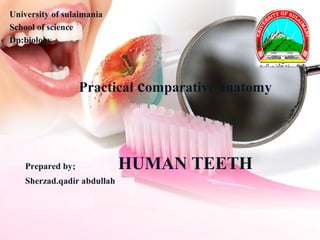
Human teeth
- 1. University of sulaimania School of science Dp:biology Practical comparative anatomy Prepared by; HUMAN TEETH Sherzad.qadir abdullah
- 2. Teeth are Made of: The hard material of the tooth is composed of calcium, phosphorus, and other mineral salts. The material in the majority of the tooth is called dentine. The hard, shiny layer that you brush is called the enamel.
- 3. Human You have teeth soTeeth bite, crush or break your food. that you can Teeth help to break down food so that your digestive system can get the nutrients out of the food. You need energy to stay alive. Humans are omnivores. They eat plants and meat In adult humans there are 32 permanent teeth.
- 4. Structure of a tooth External parts of a tooth
- 5. Internal Parts of a Tooth
- 7. ENAMEL DENTINE PULP CAVITY
- 8. TYPES OF TEETH AND FUNCTION INCISORS wide, flat, sharp cutting edge and snipping food CANINE Shaped like daggers and used for cutting gripping,ripping food. sometimes called eyeteeth. MOLARS AND PREMOLARS Flat surface used for grinding molar teeth large but pre-molar is smaller
- 9. TOOTH DECAY NERVES Blood Vessels
- 10. Tooth Eruption Chart Tooth Primary Permanent Upper Teeth Central Incisor 8-12 months 7-8 years Lateral Incisor 9-13 months 8-9 years Canine 16-22 months 11-12 years 1st Premolar - 10-11 years 2nd Premolar - 10-12 years 1st Molar 13-19 months 6-7 years 2nd Molar 25-33 months 12-13 years Wisdom Tooth - 17-21 years Lower Teeth Central Incisor 6-10 months 6-7 years Lateral Incisor 10-16 months 7-8 years Canine 17-23 months 9-10 years 1st Premolar - 10-12 years 2nd Premolar - 11-12 years 1st Molar 14-18 months 6-7 years 2nd Molar 23-31 months 11-13 years Wisdom Tooth - 17-21 years
- 11. Type of teeth
- 12. The teeth . . . humans have 8 incisors I 4 canines C 8 premolars P 12 molars M abbreviations molar pre molar
- 13. foods a re good for our te e th
- 14. Foods that cause tooth decay
- 15. cavities caused Bacteria causes a build up of plaque. Plaque acid attacks the tooth The tooth eventually rots away
- 16. Brush your teeth twice a day Try not to eat too many sweets Visit the dentist twice a year
- 18. References 1. JoelWAger III,1 Ravi K Nalla,1,2,3 Guive Balooch,1,4 Grace Kim,1,2 Megan Pugach,4 Stefan Habelitz,4 GraysonWMarshall,4 John H Kinney,5,6 and Robert O Ritchie1,2 Published online on.August 28, 2006 American Society doi:10.1359//JBMR.060816 2- Dr. Yusuf Emes Bull Int Assoc Paleodont. 2011;5(1):37- 47. Istanbul University Faculty of Dentistry, Department of Oral and Maxillofacial Surgery Istanbul, Turkey 3- www.ischool.zm/media/dentition_in_humans 4- www.auburn.edu/academic/classes/zy/../Tooth DevelopmentTxt 5- www.users.forthnet.gr/ath/abyss/dep1151.htm : 21/03/2009
- 19. THANK YOU FOR LISTENS
Notes de l'éditeur
- Crown, part above gum. Has thick outer layer called enamel.Neck, part between crown and root. Provides direct contact with gum.Root, part within the jaw. Forms the cover called cementum.
- Enamel, Dentine, Pulp Cavity, Blood Vessels, Nerves, and Fibres.
- Enamel is the surface of a tooth, part of which is exposed Made up of a hard substance that contains calcium phosphate. Dentine is the bone like structure that surrounds the pulp cavity.Made up of tiny channels containing living cells Makes the tooth sensitive. Pulp cavity is in the middle of a tooth . It has soft tissues containing blood vessels and nerves
- After a meal, bacteria in the mouth feed on any sugar present and turn it into acids. Acids eats the teeth and cause cavities. Nerves are found in the pulp cavity They make the tooth more sensitive Blood vessels are found in the pulp cavity.Blood vessels supply a tooth with oxygen and nutrients